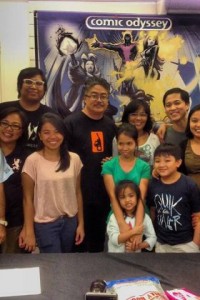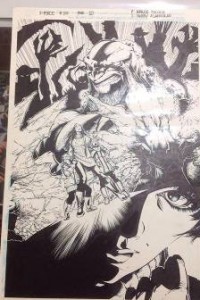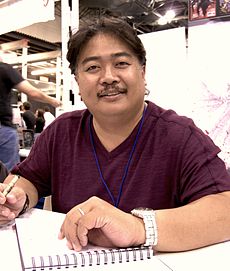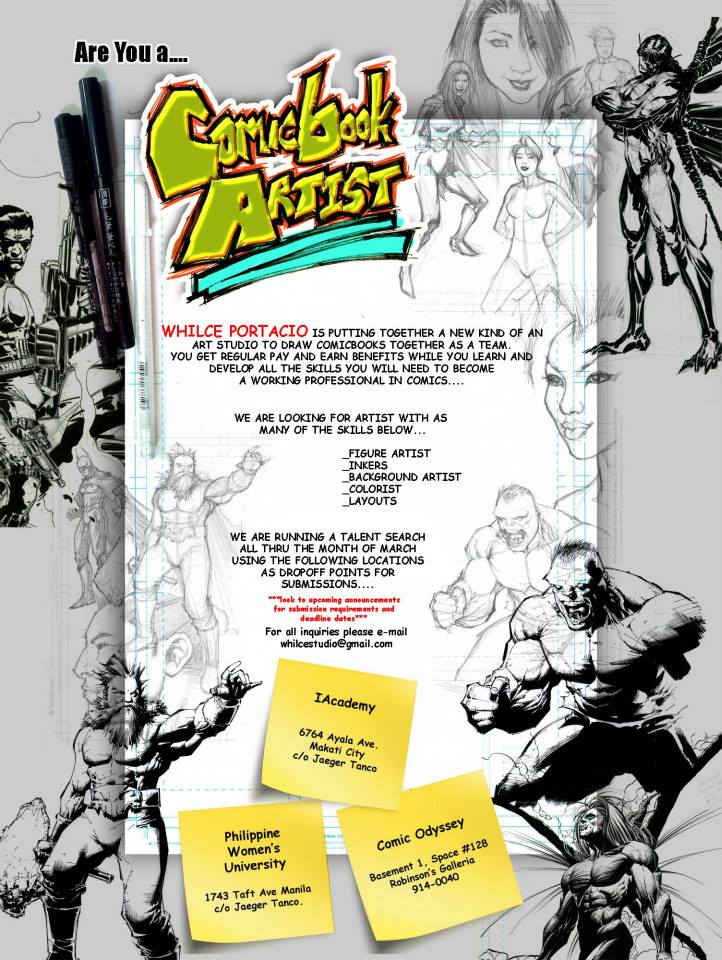LET’S TALK COMICS: An Interview With WHILCE PORTACIO
 At 50 years old, William “Whilce” Portacio still looks as formidable as the uncanny superheroes that skyrocketed his career to amazing heights.
At 50 years old, William “Whilce” Portacio still looks as formidable as the uncanny superheroes that skyrocketed his career to amazing heights.
The Filipino-American comic book creator, perhaps best known as one of the seven artistic hands that built the publishing giant Image Comics, has worked on various properties – including his own title Wetworks – during his thirty years in the comic book industry.
Getting in, through sheer Whilce-power
“I was just fortunate to live in San Diego,” Portacio reminisces. “But back then, [the San Diego Comic Con] was just a convention – it wasn’t too spectacular. It just so happened that that year, [the editors] from Marvel were there, so I brought my portfolio.”
“It’s actually fairly easy to get in[to the comics industry],” says the legendary artist, who cut his teeth inking Marvel’s Alien Legion series in 1984. “Once you have the portfolio and the skills to prove that you can do the drawings… There are so few people who can actually do that.”
According to Portacio, the powers that be in the entertainment industry – editors, directors, producers, gaming companies, and people in animation and film– are constantly on the lookout for new talent. “They hire people to go through DeviantArt, to go through conceptart.org, you know, and just look for talent,” the artist reveals, with a knowing smile.
Sometimes, new talent springs out of the most unexpected places.
“I had a friend who played Halo with his friends. And then when they stopped, he drew the mission, what they did. And then he posted it [online] for his friends to see. Well, Bungee saw it, and they asked if they could use it [as official art].”
While the good old days of breaking into comics involved hours of practice, tons of paper, and boatloads of patience while waiting in line, nowadays, it can be as simple as posting “food porn” or “selfies” on your social media accounts.
“Now, what you should do is post yourself online – Facebook, Twitter, Instagram, anywhere – just to get yourself noticed.”
If there’s one thing that still hasn’t changed, of course, it’s that one certainly needs to have the artistic chops to stand out among the crowd of talented artists waiting for their chance in the spotlight.
“Keep doing stuff. Keep posting stuff online. Do your versions of popular characters, but also create your own stuff. Get that stuff out. People are always looking. I could talk forever, but…everybody wants new stuff.”
When asked about being one of the founding fathers of Image, Portacio summed it up in three words: “It’s an honor.”
“I’m a little hesitant to answer,” admits Portacio, “because at the time, I mean, the whole of Image […] happened so fast. There was no time to think. No time to plan. It was just, ‘There’s a window there. There’s a door there. There’s an opportunity there. Sige na, tira na, let’s start, let’s do it. And let’s take it to where it would go.’ So what we did and how it inspired other people and what it did to the industry… it’s hard to think about it, even today.”
Portacio proudly proclaims that it’s the Image business model that has kept the company thriving for far longer than they initially thought. “We thought, at the most, maybe three years? Because it’s been done before, did you know that? [T]here have been different popular groups of artists like us who tried to branch out. And so we thought, maybe three years? But look, look at it now.”
“We’re not the number 1 company that sells, but we’re the number 1 company that if you have your ideas, and you want to take it somewhere, you come to us, because we’ll help you publish it, distribute it, get it out there, get people to see it… and guess what. Beyond the initial small fee, for every issue, for printing costs, we don’t take any money. So if you make a three-dollar deal later on, if you make a three-million dollar deal, it’s yours. [Image is,] to this day, still what we wanted it to be.”
“Image is the future, and it’s going to be in the future forever.”
If Robert Kirkman’s The Walking Dead – now a worldwide juggernaut that continues to call Image Comics its home – is any indication, there is certainly a market for innovative and exceptional creator-owned work, not just on the printed four-color page, but in other media as well. And Image takes pride in the fact that it lets its “children” grow freely, without asking for much in return.
Portacio – undeniably a creative and a dreamer – believes that a “creative’s dream” is to have full control over his or her own creations. “To not give a percentage, to not give up any ownership, to not give up any rights, and to not have all these extra fees on you. To be able to walk freely.”
“Do it. Invest. Take a leap of faith. Take the gamble. Create it, and make it now. The world is waiting and open for something new.”
On working with other creators (and keeping up with the times)
Portacio has good things to say about his collaborators, particularly Mike Carey, whom he had partnered with on Wetworks.
“When it gets really good, what that really means is when it really becomes a collaboration. When you’re really talking to each other, back and forth, and when you’re changing stories depending on the things that you’re thinking of at that moment. And Mike Carey’s one of the best [collaborators].”
Portacio relates how, after coming up with a new idea for a story or a character, he would submit them to Carey. Their team gelled because, as Portacio puts it, “[W]hether he really liked the idea or he just liked the idea, [Mike]’s professional enough and creative enough to singit my idea and make it seem like it was his whole, original plan. And as an artist, a collaborator, you just love, you really love, those moments. And it really is a collaboration.”
It’s this spirit of teamwork that really got the fan-turned-creator into comics, he says. “I would read Stan’s soapbox. And he would always talk about the Mighty Marvel Bullpen. The studio where Jack Kirby and Gil Kane and Neal Adams [would] get together and just draw, and it was really cool.”
Portacio identifies the “synergy” between creators as the driving force behind the formation of both Image and WildStorm Comics (with Jim Lee and Marc Silvestri). However, with the continuously changing and evolving market, Portacio also recognizes the need to remain in touch with what this generation of readers demands.
“[I]n order to do comics today, or any new property today, I have to understand what the new [consumers] want. And the only way to do that is to keep my mind open to what they want, and keep asking, and keep adjusting my stories and characters to that.”
Show the world how it’s done, Pinoy style
Portacio is confident that it’s time for Filipino artists to conquer the global scene. After all, Japan and Korea have had their shot – in television, film, music, and even comics – and now, it’s our turn.
“[We] have to get up right now with all the indie groups, all the investors and businessmen, all the creators [in all the different fields]. We have to start right now in getting that stuff out there. Because, again, there’s going to be another spot again pretty soon. And if we wait, there’s no way…. That’s not how the game is. The game is anticipating and getting in there. Cause there’s a possibility that the Philippines could be like Japan.”
“The Philippines has a better chance, because we already speak in English. We already speak in English stories and terms. So we have a better chance than the Japanese and the Koreans. We could be bigger than them, because we already understand international markets. So I’m really excited about that, and I’m really excited about talking to people.”
“I really, really feel it’s going to be our time.”
For the international artist – who remains proudly Pinoy at his very core – Pinoy comics going global may not just be an opportunity; it may even be a responsibility.
“Yung definition na alam [ng mga Amerikano sa mga Pilipino], ‘lumpia’,” Portacio quips, with a laugh. “Because every party they go to, there’s lumpia. That’s all they know. What? They’re curious. I don’t know about you, but I don’t wanna be known as lumpia. I love lumpia.”
“But I don’t just wanna be known as ‘lumpia’.”
Using the story of Lapu-Lapu and Magellan as an example, Portacio explores how our rich history can be used as a literary vehicle to build a stronger image (pun not intended) of the Filipino.
“When you tell the story of how Lapu-Lapu killed Magellan – because there’s no backdrop, no context to that, because nobody knows, nobody advertises, everybody goes, ‘Talaga?’ ‘Ganun ba?’”
Looking at how events played out, however, Portacio considers the possibilities. Spain had superior weaponry and well-armored men at its disposal, but why did it lose such a crucial battle to a small band of natives? The ships could not get within cannon range because of the shallow waters of Mactan, so the troops were forced to march down to face the datu’s forces in hand-to-hand combat. But the strain of wearing heavy armor and restrictive footwear – ill-suited for fighting on a tropical island – may have taken a toll on Magellan’s forces, leaving them vulnerable to Lapu-Lapu and his men.
“Did Lapu-Lapu plan this? Hopefully, the answer is yes. This is how he wears out his enemies. That’s why he set up his village there. Think about how this kind of information would relate to the new kids. [Filipinos are] not the laughingstocks. We’re not the ‘old men’. And then they’ll start looking around. ‘Oo nga ano.’”
“Bring everything together, and the kids will stop thinking about the old, negative things that people write about us. Just start looking around.”
The artist remains surprised and awed at how our cities have blossomed into busy urban powerhouses, with impressive malls and lively commercial spots. “Manila is still congested, traffic is still crazy, but what big city isn’t?”
“Yan ba ang mahirap? Yan ba ang Third World?”
 The key to success: Bayanihan?
The key to success: Bayanihan?
“[You] just gotta find the right pieces, put them together, and it’ll work.”
Portacio shares the Image way of approaching missed deadlines – instead of lambasting or reprimanding one another, the creators pitched in to hold the publishing schedule together.
“That’s how we did it at Image. It wasn’t just us drawing. Whenever we would be late… We would call each other every Monday. [Whenever a creator would inform us that their book’s going to be late], we didn’t say, ‘Ay, late na naman kayo,’ we said, ‘okay, this is the problem, our audience is still the same, and we have to do something to keep them.’”
Portacio calls on people in the local comics and entertainment industry – the creators, the fans, the pop culture news sites, even the folks in the indie komiks and film fields – to work together. The artist is currently looking at establishing his own studio on Philippine shores, as both a springboard for new creative work and an entry point for aspiring creators.
“When investors come back, we can really make comics work. Really make films work. Really make everything work. Really do something here.”
“And then later on, when it’s all built, you can go back to kanya-kanya. Whatever you want,” Portacio jokingly concludes.
___________________________________
Photos taken, with permission, from the official Comic Odyssey Facebook fan page.
















